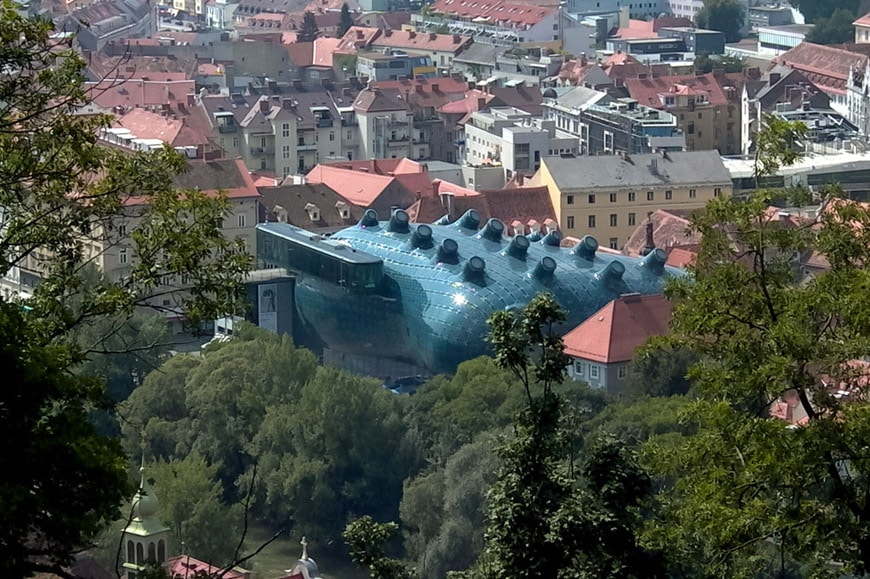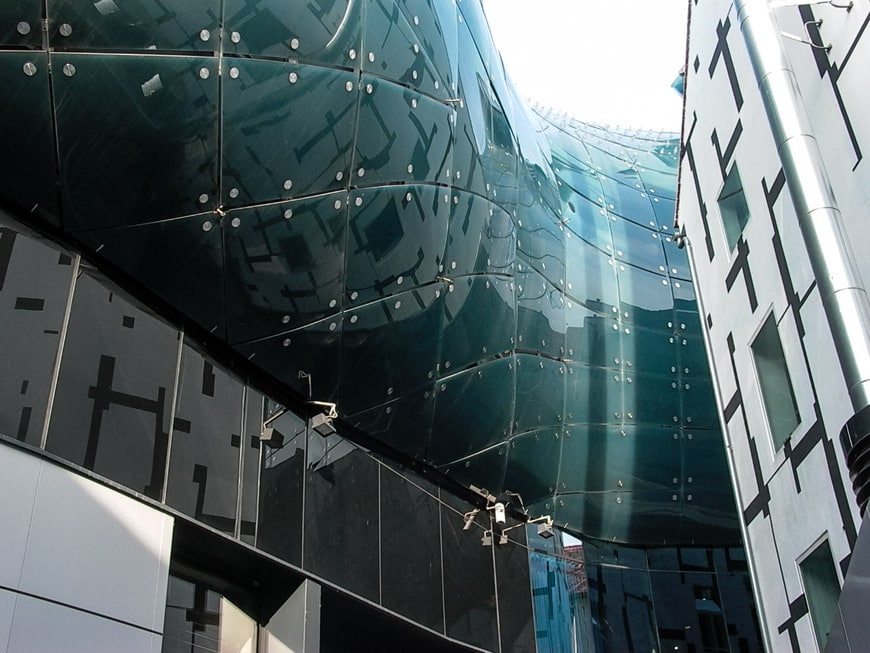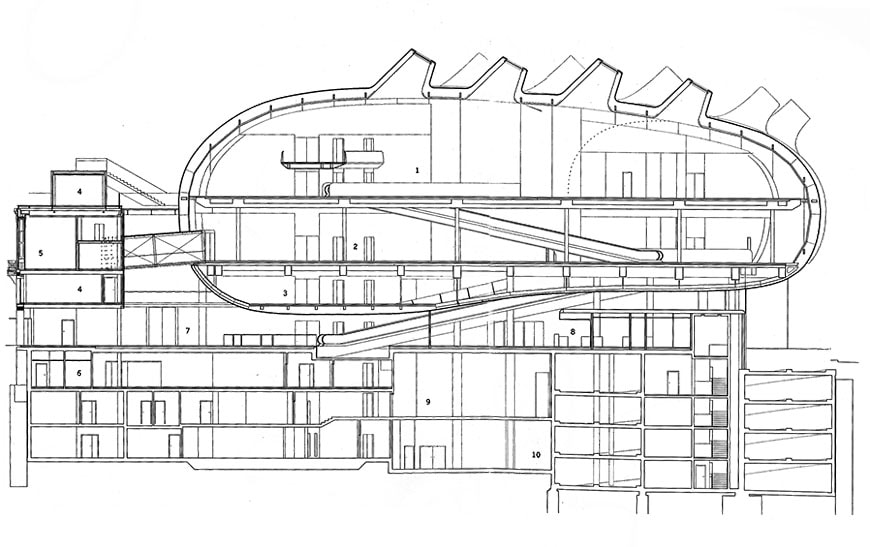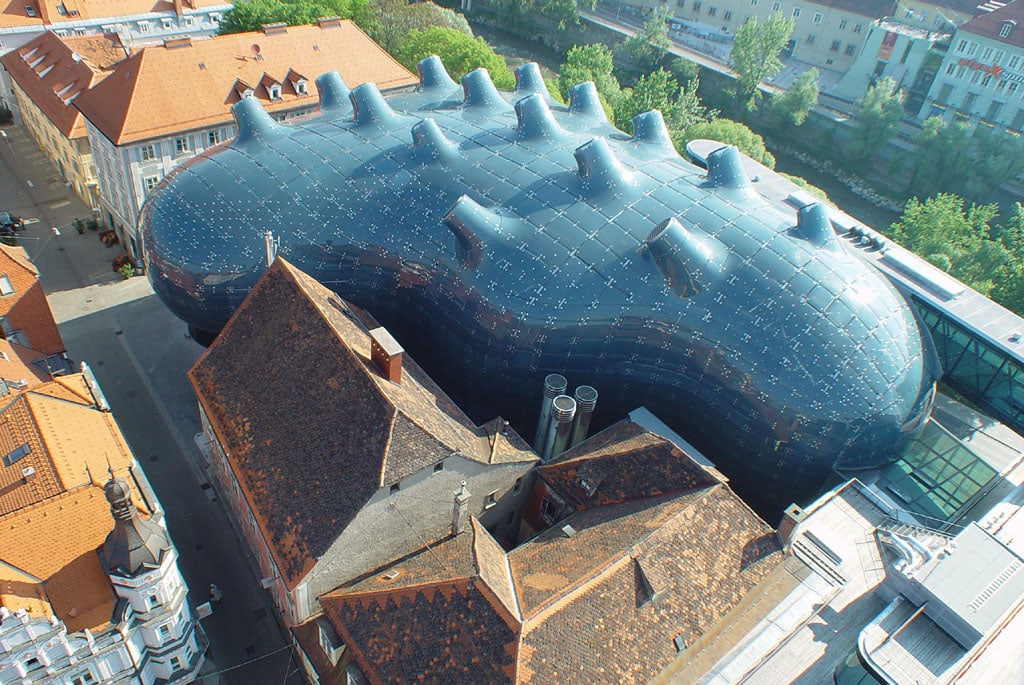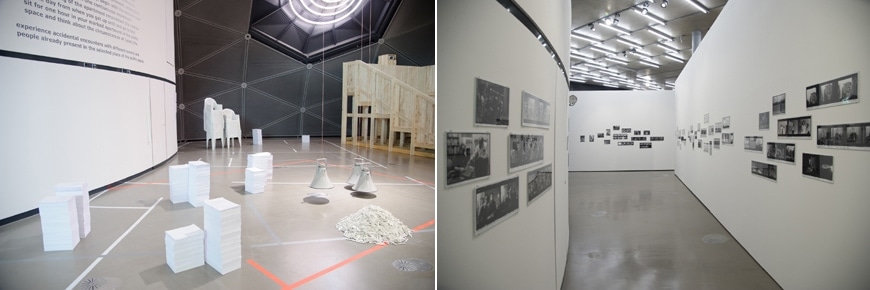Kunsthaus Graz – The Friendly Alien by Peter Cook & Colin Fournier
Steiermark, Austria
Phone: +43 316/8017-9200
Website: https://www.museum-joanneum.at/en/kunsthaus-graz
How our readers rate this museum (you can vote)

Opened in 2003, the Kunsthaus (Art House) in Graz has become one of Austria’s most significant hubs for contemporary art.
Situated in the historic center of Graz and overlooking the Mur River, the museum is housed in an iconic structure designed by British architects Peter Cook and Colin Fournier. Its biomorphic form, striking presence, and distinctive blue exterior—known as the BIX media façade—make it instantly recognizable. This façade doubles as a massive multimedia screen, reinforcing the building’s futuristic character and earning it the affectionate nickname “Friendly Alien.”
Even before stepping inside, the experience begins. Walking around the Kunsthaus, visitors sense its unusual “softness,” while its translucent cladding reflects fragments of the surrounding cityscape, turning the building itself into part of the artistic encounter.
Image above: Kunsthaus Graz, entrance on Lendkal. Photo: Universalmuseum Joanneum, Eduardo Martinez
A Landmark and Cultural Hub
Beyond its architectural fame, the Kunsthaus Graz is one of Austria’s most dynamic art centers. It regularly hosts major exhibitions featuring international and Austrian artists, architects, and designers, ensuring its role as both a cultural landmark and a lively creative stage.
Architecture and Approaches
The main entrance lies on Lendkai Street, along the Mur’s west bank, offering a sweeping view of the building. From the Schlossberg’s panoramic terrace, the Kunsthaus appears like a glowing blue form rising above the city’s red rooftops—impossible to overlook. Yet perhaps the most rewarding approach is the less obvious one: arriving from Kosakenstrasse. Slowly circling the building reveals its playful contours, material contrasts, and surprising softness, heightening the sense of discovery.
Kunsthaus Graz, view from the Schlossberg hill. Photo © Riccardo Bianchini/Inexhibit
External view of the Kunsthaus. Photo © Riccardo Bianchini/Inexhibit
Cross-section
Ground floor plan

The “Bubble” of the Kunsthaus from Mariahilferstrasse, photo © Riccardo Bianchini/Inexhibit
The BIX Media Façade
By day, the Kunsthaus’ deep blue skin dominates the cityscape; by night, it transforms into a luminous beacon. The BIX-Medienfassade, designed by Berlin-based studio realities:united, acts as a communicative surface for artistic expression.
Kunsthaus Graz, BIX media façade. Photo: Universalmuseum Joanneum, Nicolas Lackner
Aerial view, photo Zepp-Cam
The BIX Media facade at night, photo Universalmuseum Joanneum/N. Lackner
930 circular fluorescent 40 W lamps, integrated into the 900 sqm external skin, make it possible to regulate the envelope brightness. Every circular light can be assimilated to a single large pixel, controlled by a central computer. Through this system, it is possible to generate images or even low-definition videos that can be seen from a long distance, thus transforming the Kunsthaus blue bubble volume into a low-resolution mega screen.
Its 900-square-meter skin integrates 930 circular fluorescent lamps, each functioning as a pixel controlled by a central computer. This system allows the façade to display images and even low-resolution videos visible from afar, turning the building into a glowing, oversized urban screen.
Kunsthaus. Space 01. Photo: Universalmuseum Joanneum, Nicolas Lackner
One of the nozzle windows on the Kunsthaus building’s roof from the upper floor gallery. Photo: © Christian Plach
Kunsthaus. nozzle windows from the “needle”. Photo © Riccardo Bianchini/Inexhibit
Interior Spaces
Inside, the Kunsthaus offers two large exhibition halls stacked vertically: space-01 and space-02. Unlike the neutral white cubes typical of many galleries, these spaces challenge artists and curators to adapt their work to the building’s strong personality and visual power.
Over the years, their best uses have become clear:
– Space-02 (lower level) is ideal for painting, photography, and video art.
– Space-01 (upper level) lends itself to large-scale sculptures and installations.
Together, they provide a versatile yet distinctive environment that continues to redefine how contemporary art is experienced in Graz.
left: an image from the Cittadellarte, Sharing Transformation exhibition (28 September 2012 – 20 January 2013). Photo: UMJ / N. Lackner
right: an image from the Ai Weiwei Interlacing exhibition (16 September 2011 – 11 May 2012)
Photo: UMJ / N. Lackner
An image of the Needle, located on the Kunsthaus top, from which it is possible to enjoy an extraordinary panoramic view over the city. Photo © Christian Plach
An image of the Karl Neubacher exhibition at the Kunsthaus Graz, Photo: UMJ / N. Lackner
copyright Inexhibit 2025 - ISSN: 2283-5474


 (14 votes, average: 4.50 out of 5)
(14 votes, average: 4.50 out of 5)